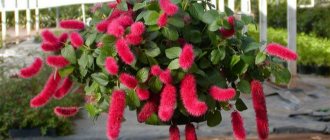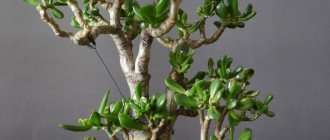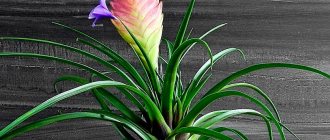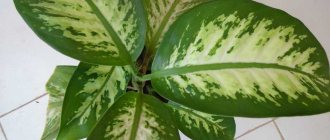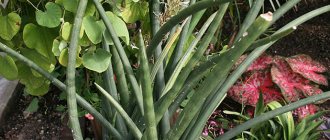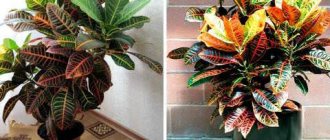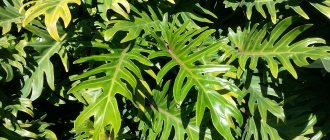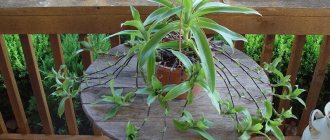Spider mite Scale insects Mealybug
Below you can see a photo of the tricolor arrowroot or prayer plant:
Home care
Caring for arrowroot at home is no different from most other plants.
When purchasing, you should carefully inspect the plant, refusing to purchase heavily overgrown, old or, conversely, young ones that have not yet gained strength, as well as weakened seedlings.
Important! The optimal time to start cultivating the flower is April - May.
Having delivered the arrowroot home, it should be protected from the harmful effects of dry room air. For this purpose, the plant is sprayed with settled warm water from a spray bottle several times a day until it adapts to its new conditions.
By the way, such hydroprocedures are necessary for a flower throughout its entire growing season: at least once a day in winter, and twice a day in summer.
Watering and spraying
Arrowroot requires abundant and regular watering to prevent excessive drying of the soil.
However, excess moisture in the substrate can be detrimental to the plant, as it leads to rotting of the root collar. Usually in summer watering is carried out every other day , and in winter - 1-2 times a week. For this procedure, use only rain, snow, boiled or settled tap water.
A reliable indicator of the need for regular watering is drying the surface layer of soil to a depth of 2 cm .
Spraying also has a beneficial effect on the plant, especially in summer.
Important! In some cases, this procedure can lead to the appearance of white streaks on the leaves. As an alternative to a wet shower, you can install plastic trays or other containers with gravel or expanded clay filled with water next to the arrowroot.
Landing
a shallow but wide ceramic or plastic pot is best This is explained by the fact that arrowroot roots do not penetrate deep into the soil, but form additional underground tubers that require sufficient free space for their development.
To grow healthy and beautiful indoor plants, it is worth preparing a balanced, breathable substrate that has a slightly acidic reaction environment.
For the latter, either ready-made store-bought formulations or self-prepared mixtures are used. The following option has worked well:
- 2 parts peat;
- 1 part coarse river sand;
- 2 parts leaf humus.
This universal mixture also deserves special mention:
- 2 parts peat;
- 4 parts leaf humus;
- 1 part rotted manure;
- 1 part river sand.
To make the substrate more loose, you can add pine bark, sphagnum, crushed charcoal or coniferous soil . Additionally, drainage is arranged by pouring expanded clay, broken brick or small crushed stone into the bottom of the flower pot in a layer of up to 5 cm.
The video shows the main points of flower care:
Reproduction
There are several ways to propagate the plant.
- Dividing the bush . In this case, when transplanting arrowroot, the mother rhizome is divided into several daughter tubers with well-developed roots and leaf blades. Young individuals are planted in separate containers with loose, light soil and covered with cellophane film or a plastic cap for better survival. After this, the pots are placed in a warm place for final rooting of the plants.
- Cuttings . From the apical shoots, take a section of the stem 8–10 cm long with two internodes and several healthy leaves, and then place it in a container with settled water. To speed up the formation of roots, the cuttings are treated with a growth stimulator. The germination process usually takes 1 – 1.5 months. After this, the cuttings are transplanted into a breathable peat-sand substrate and watered well. For quick rooting of seedlings, small greenhouses are set up.
Biological characteristics of arrowroot
Perennial herbaceous decorative deciduous and beautiful flowering species; the height of plants in natural conditions is 20-30 cm. indoor species of individual cultivars reach up to 1.5 m; the root system is located in the upper layer of soil and consists of a tuberous or oblong rhizome, which serves as a water storage during the dry period, with thin roots that supply the plant with moisture and nutrients; shoots straight or creeping; basal leaves are rosette, stem leaves are arranged in two rows; leaf blades range in color from white to dark green and almost black. Variegated leaves are distinguished by brightly colored spots and veining of 2-3 color shades; the upper and lower sides of the leaf blades have different shades; depending on the lighting, the leaf blades are arranged horizontally (under optimal conditions) or vertically folded together, curling into a tube or half-tube (under unfavorable factors);
Lighting
Arrowroot does not tolerate direct sunlight, however, strong shading also negatively affects its appearance: the leaf blade decreases in size, losing its rich greenish color.
Plants feel best either in bright diffused light (partial shade) or in artificial lighting with fluorescent lamps for 16 hours a day.
Important! The ideal location of the flower indoors will be the central part of the room, and in winter - the windowsill, where the plant will receive more solar energy.
Botanical description of the plant
Tricolor, or red-veined arrowroot (lat. Maranta tricolor) is part of the family of the same name. Her homeland is Brazil.
Because of the interesting behavior of the tricolor arrowroot when the light changes, it is popularly called a prayer plant or the “10 Commandments.” In daylight, its leaves are located horizontally, in the dark they rise upward. This ability is necessary for the flower to retain moisture, reducing evaporation, and thereby avoid sunburn.
The main characteristics of the flower are collected in the table:
| Root system | tuberous, superficial |
| Stem | height up to 20–25 cm |
| Leaf Shape | oval |
| Leaf color | dark green with pale edges, red veins and a yellowish feather pattern |
| Inflorescence shape | ear |
| Flower color | lilac |
Benefits and harms
The decorative form of this plant is valued by gardeners for its beautiful rosette of oval leaves, the color of which is dominated by various shades of green, complemented by an accent in the form of bright veins, stripes and spots.
A close relative of this flower, reed arrowroot, is widely used in cooking. Here, underground tubers rich in starch (up to 25%) are used. From them, flour is obtained, which is used to prepare nutritious puddings, sauces, soups, stews and baked goods.
Various types of arrowroot also have healing properties. It is believed that a pot with a living plant placed next to your sleeping place can cure insomnia . A number of amateur flower growers believe that it harmonizes the internal living space, helps cope with bad moods and attacks of aggression, and smoothes out quarrels.
Arrowroot does not have a , since it does not secrete toxic milky juice and does not have sharp edges that lead to cuts.
Important! In any case, caution must be exercised by people suffering from severe forms of allergic diseases and bronchial asthma.
Popular indoor varieties
There are several indoor species of this flower.
White veined (Maranta leuconeur). This type of flower gets its name from the bright, distinct whitish veins on the leaf. The underside of the leaf has a burgundy-violet color. The stems are short in size - about 16 centimeters, and the leaves, on the contrary, are wide and long - about 6-8 centimeters in width and 11-16 centimeters in length. The leaves are oval in shape with a dark green tint. The leaves have light green patterns, and silvery white veins are visible at the top.
Bicolor (Maranta bicolor). It differs in that it lacks tubers on the roots and has 2 main tones. The flower can form a bush with a height of 21 centimeters. The leaves are located on long red petioles and may have an oval shape and wavy edges. The main background of the leaf has a gray-green color, and some of them have a dark green tint. There are oval dark brown spots along the entire length of the leaf, along the main vein. The reverse side of the leaves is purple in color.
Reed-like (M. arundinacea). It is very tall - this arrowroot can reach a height of 1.5 meters. It has tuberous roots with starch components. It has a peculiarity - in winter the stems dry out. The leaves are long, ovate-lanceolate, and their length is 11-13 centimeters with a width of 8 centimeters. The leaf has a rounded shape at the base and a pointed tip. The leaves are dark green above, gray-green below, and the flowers of this species are single and white.
Gibba (Maranta gibba). This species is rarely found, but can be found in botanical gardens. The leaves are ovoid or oval in shape and reach a length of 11-16 centimeters. The leaf is velvety on top and smooth underneath. The main background is light green. Along the main vein of the leaf there are dark green wide stripes. The flowers are unusual - bright, lilac in color.
Arrowroot reed (reed-like) - true arrowroot
Arrowroot reed
Grows in tropical regions. The tallest variety reaches up to 1.3 meters in height. The leaves are dark green, long, ovoid, with a pointed edge, and have a bluish tint. Stems are dense and erect. The root system is densely covered with tubers. The tubers of the plant contain about 25% starch; when boiled, they are eaten. From the rhizome, flour is obtained - “arrowroot”. The rhizomes are dug up when the plant reaches one year of age. The flowers are white. Sometimes in medicine this variety is used as a medicinal product.
Tricolor arrowroot
It is distinguished by red veins on the leaf blade. The color of the leaves also contains green and yellow. The reverse side of the sheet is painted crimson.
Maranta Kerkhoven
The main color is light green, with brown spots in the form of strokes, clearly visible in the photo.
The most unpretentious variety. It is often used for landscaping offices where lighting is insufficient.
Maranta Massanja
This variety is very capricious, distinguished by a very dark, almost black color. Light green veins stand out in contrast against the general background.
Bicolor (Maranta bicolor)
It is often found on sale and in popular scientific publications on floriculture as comb arrowroot (Maranta cristata). Distinctive features of this species are the absence of tubers on the roots and the presence of two primary colors. The plant does not droop, forms a bush, up to 20 cm high.
The leaves are on tall reddish petioles, oval in shape, with a wavy edge. The main color of the leaf blade is gray-green, in some varieties it is dark green. Along the entire length of the leaf, along the central vein, there are oval dark brown spots. The reverse side of the leaves is colored purple.
Comb arrowroot
A medium-sized bush reaches approximately 40 cm. The succulent creeping rhizome is short, with fusiform thickenings for the accumulation of nutrients and moisture. The leaves are wide or oblong, up to 15 cm. The edges of the plate are slightly wavy.
The peculiarity of the comb arrowroot is its color. A continuous light green ridge appears on the green leaf, from which broad dark strokes radiate. They form a continuous border, and the ridge gradually becomes sharper.
Diseases and pests
Spider mite
This is one of the most dangerous plant pests. It settles on the underside of the leaf blade, causing the appearance of white spots and a thin cobweb. Over time, the leaves lose their usual color and fall off.
To prevent this phenomenon, it is necessary to avoid excessive dryness of the air in the room by periodically spraying the flower with water. When the disease has already developed, special insecticidal preparations are used, in particular “Fitoverm”, “Aktellik”, “Funanon”, etc., as well as pollination with sulfur preparations in the open air outside the living room.
Shields
A sign of damage by this pest is the appearance of brown protrusions on the leaves and stems. The leaf blade dries out, curls, loses its characteristic color and falls off (read more about what to do if arrowroot leaves turn yellow and dry, as well as what diseases and pests can destroy a flower and how to treat the plant).
A radical means of combating this disease is either washing the affected areas of the plant with a 5% soap emulsion (20 grams of laundry soap per 10 liters of water), or spraying with an Actellika solution prepared at the rate of 1 - 2 ml of product per 1 liter of water.
Mealybug
It primarily affects leaf petioles. To destroy it, the same drugs are used as in the case of scale insects. If necessary, treatment is carried out repeatedly until a lasting result is achieved.
Arrowroot tricolor is not a simple plant, since its normal growth and development requires strict adherence to cultivation techniques. However, all these efforts will pay off handsomely, because “praying grass” is one of the most beautiful tropical plants that will delight the eye with luxurious velvety leaves with a unique pattern for many years.
Possible problems with growing tricolor arrowroot
Inexperienced flower growers who grow prayer flowers at home and do not know how to properly care for them often encounter difficulties and problems. Here are some of them and tips for eliminating them:
Yellowing of leaves. It can be caused by completely unacceptable factors for plants: drafts, low temperature or humidity, burns from direct sun. The sooner these destructive conditions are eliminated, the easier it is to save the plant.- Drying flower. At the same time, dark spots appear on the leaves. In addition to the reasons listed above, this can occur due to lack of nutrition or due to leaching of the soil. The addition of peat and organic matter helps here. Watering with acidified water is also useful.
- Curling of leaves. It occurs when there is a lack of heat or moisture.
- Slow growth or drying of leaf tips - excess lighting or phosphorus fertilizing.
- Spots on the leaves are fungal diseases due to moisture getting on the leaves. In this case, fungicides help.
- A whitish coating on the leaves is the presence of mealybugs, cobwebs and yellowish dots on the plant – the presence of spider mites. These pests appear when plants are insufficiently moistened. They and scale insects that form a sticky coating on flowers, as well as thrips, are combated with the help of insecticides.

